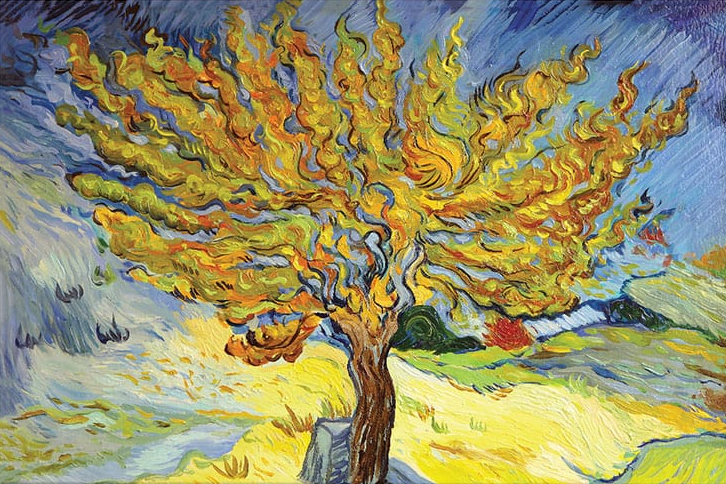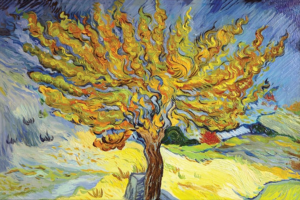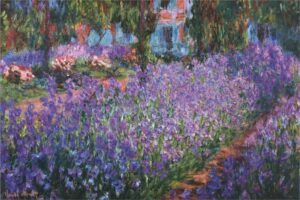“Mulberry Tree” is a painting by the famous Dutch post-impressionist artist Vincent van Gogh. It was created in 1889 during his time at the Saint-Paul-de-Mausole asylum in Saint-Rémy-de-Provence, France. This painting is part of a series of works that Van Gogh produced during his stay at the asylum.
The painting depicts a mulberry tree in a vibrant and expressive style, which is characteristic of Van Gogh’s later works. The tree dominates the composition with its twisting branches, and the leaves are rendered in a variety of green and yellow tones. The sky in the background is painted in shades of blue and white, creating a strong contrast with the tree.
Origin of the Painting
The mulberry tree itself was located in the garden of the asylum, where Van Gogh was a patient. The tree and its surroundings became a source of inspiration for him during this period. He found solace and beauty in nature, and the tree symbolized resilience and the changing seasons.
Van Gogh’s mental health was fragile during his time at the asylum, and he often turned to art as a way to express his emotions and thoughts. The Mulberry Tree painting is a testament to his artistic exploration and his ability to find beauty and meaning even in challenging circumstances.The painting is characterized by swirling brushstrokes, vibrant colors, and a sense of movement. It showcases Van Gogh’s unique style and his fascination with the interplay of light and color in the natural world.
Who’s Vincent Van Gogh?
Vincent van Gogh (1853-1890) was a Dutch post-impressionist painter who is widely regarded as one of the most influential figures in the history of Western art. He is known for his distinctive style characterized by bold brushwork, vivid colors, and emotional intensity. Van Gogh’s works often depict landscapes, portraits, and still lifes.
During his lifetime, van Gogh struggled with mental health issues and poverty, which led to a tumultuous life and a relatively limited recognition as an artist. However, his artistic vision and unique approach to painting have since gained significant appreciation and have had a profound impact on subsequent generations of artists.
Some of his most famous paintings include “Starry Night,” “Sunflowers,” “The Bedroom,” and “The Café Terrace at Night.” Despite facing personal challenges, van Gogh’s contributions to art have left an enduring legacy, and his works continue to be celebrated and studied around the world.

>Shop Mulberry Tree Print Reproduction
What Makes “Mulberry Tree” So Unique…
In “Mulberry Tree,” Van Gogh effectively merged his emotional state with the depiction of nature. The swirling patterns and intense colors convey a sense of movement and energy, almost as if the tree is alive and responding to the artist’s emotions. This fusion of nature and emotion is a hallmark of Van Gogh’s style.
Van Gogh’s distinct and bold brushwork is evident in “Mulberry Tree.” He used thick, swirling, and visible brushstrokes to create texture, movement, and depth in the painting. This technique adds an emotional intensity to the artwork, reflecting the artist’s inner turmoil and his attempt to convey his emotions onto the canvas.
The painting features a vibrant and contrasting color palette that is characteristic of Van Gogh’s style. He used vivid hues of green, blue, and yellow to depict the leaves of the mulberry tree and the surrounding landscape. This use of color not only captures the visual essence of the scene but also serves to evoke a sense of emotion and energy.
Significance of “Mulberry Tree”
“Mulberry Tree” by Van Gogh is significant for its embodiment of the artist’s emotional expression, its symbolism, its representation of his personal struggles, and its contribution to the evolution of artistic styles. It stands as a testament to van Gogh’s artistic vision and his ability to convey complex emotions through his vibrant and evocative paintings.
During his time at the asylum, Van Gogh continued to experiment with his artistic techniques and approach. “Mulberry Tree” showcases his ongoing exploration of color, texture, and form. The painting’s unique style reflects Van Gogh’s willingness to push the boundaries of traditional art techniques and his commitment to expressing his inner world through his work.
Conclusion
In summary, “Mulberry Tree” is unique due to its expressive brushwork, vibrant color palette, symbolic meaning, fusion of nature and emotion, and Van Gogh’s artistic experimentation. It stands as a testament to the artist’s ability to translate his emotions and perceptions onto the canvas, creating a visually captivating and emotionally charged artwork.
You can shop “Mulberry Tree” print reproduction from our shop. Check out all of our fine art prints to display in your home.











